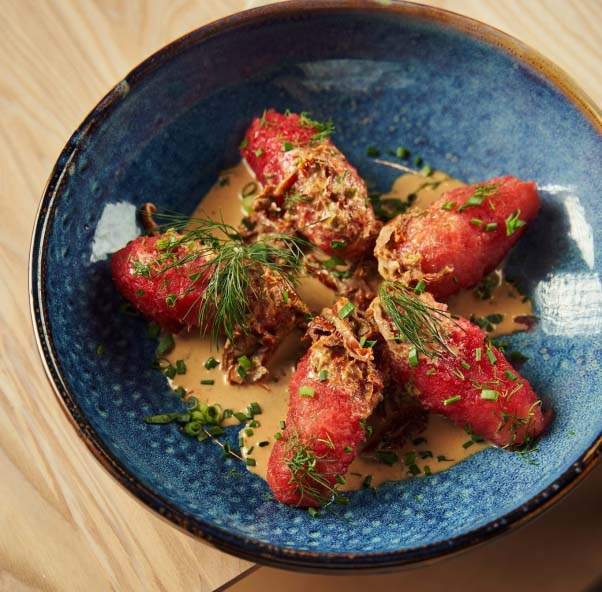Globally, there’s been an ongoing trend of reinventing traditional, time-honored recipes to suit the increasingly changing global tastes that are shifting towards more healthy plant-based alternatives. Similarly, local chefs in Lithuania have been revamping traditional meat-heavy dishes like cepelinai.
According to the data of the United Nations Food and Agriculture Organization, today an average Lithuanian consumes around 250 grams of potatoes per day, totalling to almost 100kg annually. Over the years, the nation has found multiple ways to utilize this versatile vegetable in various dishes—cepelinai, stuffed potato dumplings, being one of them. While most locals still enjoy the traditional version of the dish, the modern health-conscious trends have resulted in a proliferation of plant-based cepelinai varieties.
“Cepelinai used to be the perfect hearty meal delivering the necessary energy that our predecessors needed to endure the cold climate while working the fields,” said Snieguolė Valiaugaitė, Communication Project Manager at Lithuania Travel. “The times have changed, so has Lithuanian cuisine: over the last few decades, the local chefs have introduced foreign flavors to cepelinai and have transformed it to a healthy everyday dinner or lunch option.”
The centuries-old recipe varies from family to family and differs between the ethnographic regions. Traditionally, cepelinai is made from grated potato dough, stuffed with either pork or curd filling and served with crispy pork-belly bits, caramelized onions, and sour cream.
Offering a fresh broad palette of flavors, the restaurants around the country have been reinventing cepelinai by introducing new unexpected plant-based fillings, ranging from buckwheat to cottage cheese and mint. The vegetarian and vegan options are becoming increasingly popular, despite the fact that traditionally, ground pork has been the most common cepelinai stuffing.
According to Lithuania Travel, some of the most interesting new and more traditional cepelinai varieties can be found in Lithuania’s biggest cities: Vilnius, Kaunas, and Klaipėda. The gourmet options include ones at Queensberry in Vilnius with a carrot and hemp seed stuffing; as well as ones filled with mushrooms, vegetables, and sunflower seeds at Sultenė.
Besides the new plant-based varieties appealing to the younger generation that is increasingly welcoming vegetarian-inspired options in the traditionally meat-obsessed country, there are also revamped varieties of cepelinai that appeal to gourmet omnivores. Among them are the pulled duck option served at Burna House in Vilnius and the wild game variety prepared by the chefs at restaurant Lokys, also located in the country’s capital.
More information about Lithuanian gastronomy—including tips for tasting both authentic and modernized national cuisine of Lithuania is available here.

Ingredients (makes 4 servings)
For the potato mixture:
800 grams of raw blended potatoes
300 grams of fresh potatoes (peeled)
100 grams of finely chopped onions
60 grams of milk
60 grams of butter
250 grams of fresh beetroot juice
40 grams of potato starch
For the stuffing:
400 grams of cottage cheese
2 grams of fresh tarragon
40 grams of sour cream
For the white wine sauce with sundried tomatoes and capers:
400 grams of heavy cream
100 grams of white wine (dry)
80 grams of sundried tomatoes
10 grams of capers
5 grams of cornstarch
15 grams of salt
10 grams of fresh thyme
20 grams of cooking oil
For garnish:
Chopped dill
Chopped spring onions
Chopped parsley
Black pepper
Preparation
1. Cook the freshly peeled potatoes in salted water and drain them. Heat the milk until it starts boiling, add it to the potatoes along with the butter. Mash until smooth.
2. Mix the mashed potatoes with the raw blended potatoes and the beetroot juice. Add 5 grams of salt
3. For the stuffing mix the cottage cheese with the tarragon, sour cream, and 3 grams of salt.
4. To form a single cepelinas take 50 grams of the potato mixture and pat it flat in the palm of the hand. Place 20 grams of the stuffing in the center and, using slightly dampened hands, fold the potato mixture around the cottage cheese stuffing into a zeppelin shape, sealing well.
5. Mix 2,5 liters of water with the beetroot juice and bring it to a boil. Gently lower the cepelinai into the boiling water and juice mixture and cook for 15 minutes on low-to-medium heat.
6. For the sauce saute the onions on some cooking oil until golden brown. Add the wine and fresh thyme. Cook for 7-10 minutes until the alcohol evaporates. Add the cream, bring it to a slow boil and simmer for 15 more minutes on low heat. Add the sundried tomatoes and the capers and bring it to a boil. To thicken the sauce, add the cornstarch.
7. Serve the cepelinai with the white wine sauce and garnish with fresh dill, spring onions, ground black pepper, and parsley.
Lithuania Travel is a national tourism development agency responsible for Lithuania’s tourism marketing and promotion, acting under the Ministry of Economy and Innovation. Its strategic goal—to raise awareness of Lithuania as an attractive tourism destination and to encourage inbound and domestic travel.

